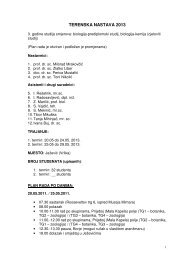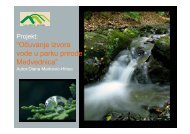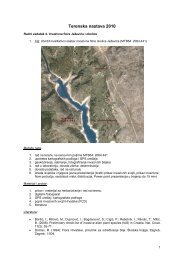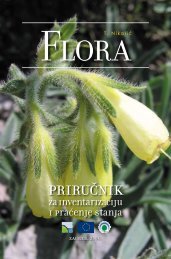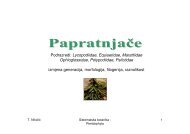important plant areas in central and eastern europe - hirc.botanic.hr ...
important plant areas in central and eastern europe - hirc.botanic.hr ...
important plant areas in central and eastern europe - hirc.botanic.hr ...
You also want an ePaper? Increase the reach of your titles
YUMPU automatically turns print PDFs into web optimized ePapers that Google loves.
Section 6Forests <strong>and</strong> forestryForests are key habitats for the conservation of many rare <strong>plant</strong>, fungi, moss <strong>and</strong> lichenspecies. Europe has a wide diversity of forest types from the expanses of conifer forests<strong>in</strong> the north <strong>and</strong> the Baltic, to the unbroken belts of oak-beech <strong>and</strong> beech-spruceforests of <strong>central</strong> Europe <strong>and</strong> the species rich deciduous <strong>and</strong> mixed forests of southernEurope. Some of the forests of southern Europe were not affected by glaciation <strong>and</strong>have forest compositions that have existed for many thous<strong>and</strong>s of years. Old growthforests, <strong>areas</strong> where there has been little or no human activity for over one hundredyears, are extremely species rich.They are <strong>in</strong>creas<strong>in</strong>gly rare <strong>and</strong> these few rema<strong>in</strong><strong>in</strong>g<strong>areas</strong> should be prioritised for protection. Susta<strong>in</strong>able management should be appliedalso <strong>in</strong> forests that are commercially exploited.Several million people are employed <strong>in</strong> the forestry <strong>in</strong>dustry <strong>in</strong> Europe today, <strong>and</strong>forestry is an <strong>important</strong> economic sector.There is an urgent need to f<strong>in</strong>d a susta<strong>in</strong>ablebalance between the needs of economic forestry <strong>and</strong> the need to conserve Europe’sforest heritage for the future.T<strong>hr</strong>eatened forest habitatsThe EU Habitats Directive recognises 65 t<strong>hr</strong>eatened forest habitats <strong>and</strong> the Council ofEurope, Bern Convention recognises 109 t<strong>hr</strong>eatened forest habitats, such as the Alvarforests of Estonia, flood pla<strong>in</strong> forest, beech forests <strong>and</strong> Scots p<strong>in</strong>e forests. Many ofEurope’s rarest tree species are listed <strong>in</strong> the World List of T<strong>hr</strong>eatened Trees.The most <strong>important</strong> impacts of human activity on forest biodiversity are:• Clear<strong>in</strong>g old growth <strong>and</strong> deciduous forest <strong>and</strong> replac<strong>in</strong>g them with <strong>plant</strong>ations ofexotic <strong>and</strong> coniferous species.• Harvest<strong>in</strong>g of trees before they reach maturity, which results <strong>in</strong> a decrease <strong>in</strong> thenumber of species associated with old <strong>and</strong> decay<strong>in</strong>g trees.• Clear<strong>in</strong>g of alluvial forests for agriculture <strong>and</strong> <strong>plant</strong>ations of fast grow<strong>in</strong>g hybridpoplars, <strong>and</strong> chang<strong>in</strong>g the hydrological systems of swamp forests• Modify<strong>in</strong>g the species composition of exist<strong>in</strong>g forests <strong>and</strong> creat<strong>in</strong>g formations that donot occur naturally• Dra<strong>in</strong><strong>in</strong>g of peat soils <strong>and</strong> humid forests to accelerate forest growth• Construct<strong>in</strong>g timber road networks <strong>in</strong> wilderness <strong>areas</strong>• Reforestation of ab<strong>and</strong>oned agricultural l<strong>and</strong> <strong>and</strong> formerly grazed environmentsQuality not quantity: afforestation <strong>in</strong> EuropeThe area of forest <strong>in</strong> Europe is <strong>in</strong>creas<strong>in</strong>g, partly t<strong>hr</strong>ough afforestation programmes cof<strong>in</strong>ancedby the EU (1 million hectares s<strong>in</strong>ce 1991), but also t<strong>hr</strong>ough natural regenerationon agricultural <strong>and</strong> formerly grazed l<strong>and</strong>. Although this is generally viewed as a positivetrend, there are concerns for <strong>plant</strong> conservation.• In afforestation projects, the preference for conifers over deciduous trees, <strong>and</strong> exoticover <strong>in</strong>digenous species, has a negative effect on biodiversity• The rise <strong>in</strong> forest area conceals the fact that many of the last old growth forests <strong>in</strong>Europe are still t<strong>hr</strong>eatened with deforestation <strong>and</strong> replacement with <strong>plant</strong>ations• Afforestation projects often occur on key natural <strong>and</strong> semi-natural open <strong>and</strong> grassl<strong>and</strong>habitats.All afforestation programmes should be subject to thorough <strong>and</strong> effective environmentalimpact assessments to ensure that Europe’s most valuable forests are not lost <strong>in</strong> thenumbers game of quantity rather than quality.84








